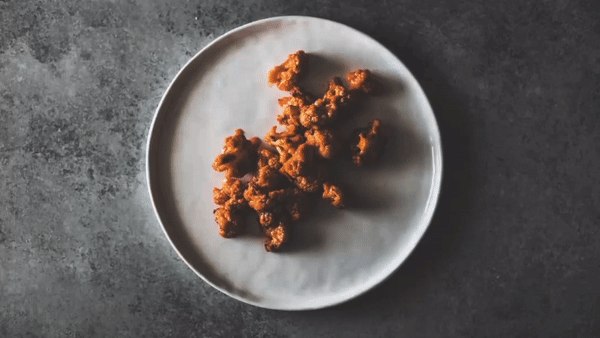Exploring the secrets of Korean cuisine, the book caters for novices as well as the more experienced, from stir-fried spicy squid, to sesame and soy marinated beef. The recipes have been created by acclaimed food writer Jordan Bourke and his Korean wife Rejina, whose culinary history forms the basis of the book.
Alongside the recipes there are notes on dining etiquette, a list of key ingredients that are used throughout the book and how and when to use many of the side dishes.
Haemul pa-jeon – Seafood and Spring Onion Pancake
200g mixed squid rings and prawns
4 garlic cloves, crushed
1tsp toasted sesame seeds
2tsp roasted sesame seed oil
100g plain flour (or white spelt flour)
3 level tbsp glutinous rice flour (or cornflour)
2 eggs, beaten
2tbsp sunflower oil
6 spring onions, sliced lengthways
½ green chilli, deseeded and sliced
½ red chilli, deseeded and sliced
sea salt and freshly ground black pepper
Dipping sauce
2tbsp soy sauce
1tsp rice wine vinegar
½tsp roasted sesame oil
1 small garlic clove, crushed
¼tsp toasted sesame seeds
This dense, savoury pancake makes a fantastic starter or sharing dish with everyone diving in with their chopsticks, mopping up some of the soy dipping sauce along the way. Extremely popular as a snack in Korea, you can make it on your own with whatever selection of seafood you like. A plain spring onion version of the pancake, without any seafood, is also a very popular Korean dish, so feel free to leave out the fish if you prefer – just double the quantity of spring onions.
In a bowl, combine all the dipping sauce ingredients together and set aside. Wash the seafood and drain. Place it in a bowl with half the crushed garlic, the sesame seeds, sesame oil and a pinch of salt and pepper. Set aside. In a separate bowl, combine the flours with a ¼ teaspoon of salt, then add half the beaten egg, the remaining garlic and slowly whisk in 150ml of ice-cold water. (Do not add in all the water at once, as you may not need the full amount.) The batter should be the consistency of thick pouring cream. If you are not using fish, add the garlic, salt, sesame seeds and sesame seed oil straight into the batter.
Place a 22cm non-stick frying pan over a medium heat, add the sunflower oil and when hot ladle in 2 thirds of the batter. Use the back of a spoon to coat the base of the pan with the batter. Place the spring onion strips onto the pancake, with the green ends lying in both directions, then scatter over the chillies and seafood. Add the remaining beaten egg to the remaining batter and whisk to combine, then drizzle it over the spring onions and seafood so that they do not come loose when flipping the pancake. Fry over a medium heat for 3 – 4 minutes until the bottom is set then carefully invert the pancake onto a plate and slide it back into the pan and fry for a further 3 – 4 minutes, or until the fish is cooked through and the pancake is golden and crispy.
Serve immediately, dividing up the pancake into bite-size pieces, with the dipping sauce alongside.
Oh-ee kimchi - Almost-instant Cucumber Kimchi
3 Persian (pickling) cucumbers or 1 regular cucumber
1tsp fine sea salt
1 garlic clove, crushed
2tsp gochugaru red pepper powder (or a little less if you prefer)
2tsp unrefined sugar or coconut palm sugar
2½tsp rice wine vinegar
2tsp roasted sesame seed oil
2tsp toasted sesame seeds
This is for those days when you open the fridge and realise that you are out of kimchi! All is not lost however, as this almost instant cucumber kimchi can be made in no time, omitting the fermentation process. The shorter, squatter Persian cucumber – sometimes labelled as pickling or baby cucumber – is ideal for this recipe, being less watery with a more pronounced flavour. Persian cucumbers are easily available in good supermarkets and fruit and veg markets. If you can’t find it, you can use normal cucumber, but it will be a little more watery.
Wash the cucumbers and pat them dry. Halve them lengthways and then slice them into very thin half-moon shapes. Put the slices in a bowl with the salt and combine together. Set aside for 30 minutes. Combine the remaining ingredients, apart from the sesame seeds, in a bowl. Drain the cucumbers of any liquid then add them to the bowl. Gently, but thoroughly, combine. Cover and refrigerate for at least half an hour or until chilled. Serve sprinkled with the sesame seeds. It will keep for up to a week in the fridge if stored in an airtight container.
Paeju gui – Scallops with Salted Sesame Oil
Serves 6
12 scallops
1½tbsp vegetable oil
1 garlic clove, crushed
squeeze of lemon juice
1tsp toasted sesame seeds
1tsp chopped chives
sea salt and freshly ground black pepper
Salted sesame oil
1tbsp roasted sesame seed oil
½tsp sea salt
One of the chefs I’ve worked with used to make this as a snack – it’s such a simple dish, and so quick, so we often make it when having guests over. The scallops work really well as a canapé or as a light starter, where you can serve them on or off the skewers. The sesame salt is unadorned here, so make sure to use good-quality roasted sesame seed oil. Soak 6 wooden skewers in water for 15 minutes. In a small serving dish, mix together the sesame seed oil and salt.
Rinse the scallops and cut off the tough white muscle tissue on the side. If preferred, you can also remove the orange-coloured roe, but we think they taste great and have a brilliant colour. Heat the oil in a pan over a high heat. Thread 2 scallops onto each skewer. Lightly season both sides with salt and pepper.
When the pan is very hot, place the skewers flat onto the pan (cook in batches if there is not enough space) and fry, undisturbed, over a high heat for 1 minute until golden.
Flip over and fry for 40 seconds. Then add the garlic and a squeeze of lemon juice. Fry for another 10 seconds, just to allow all the flavours to come together, making sure the garlic does not burn. Then remove from the heat.
Serve immediately with the sesame seeds and chives scattered over the top and the salted sesame oil on the side to dip into.
Subscribe to:
Post Comments (Atom)













0 comments:
Post a Comment